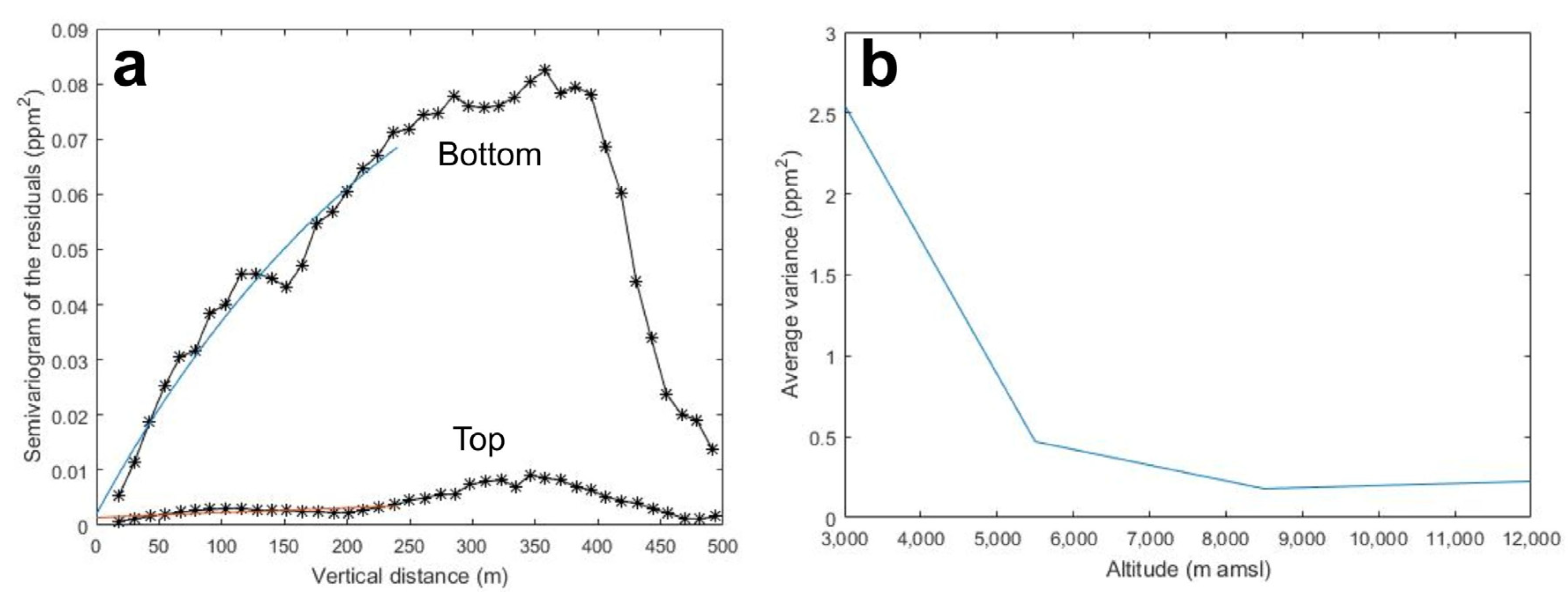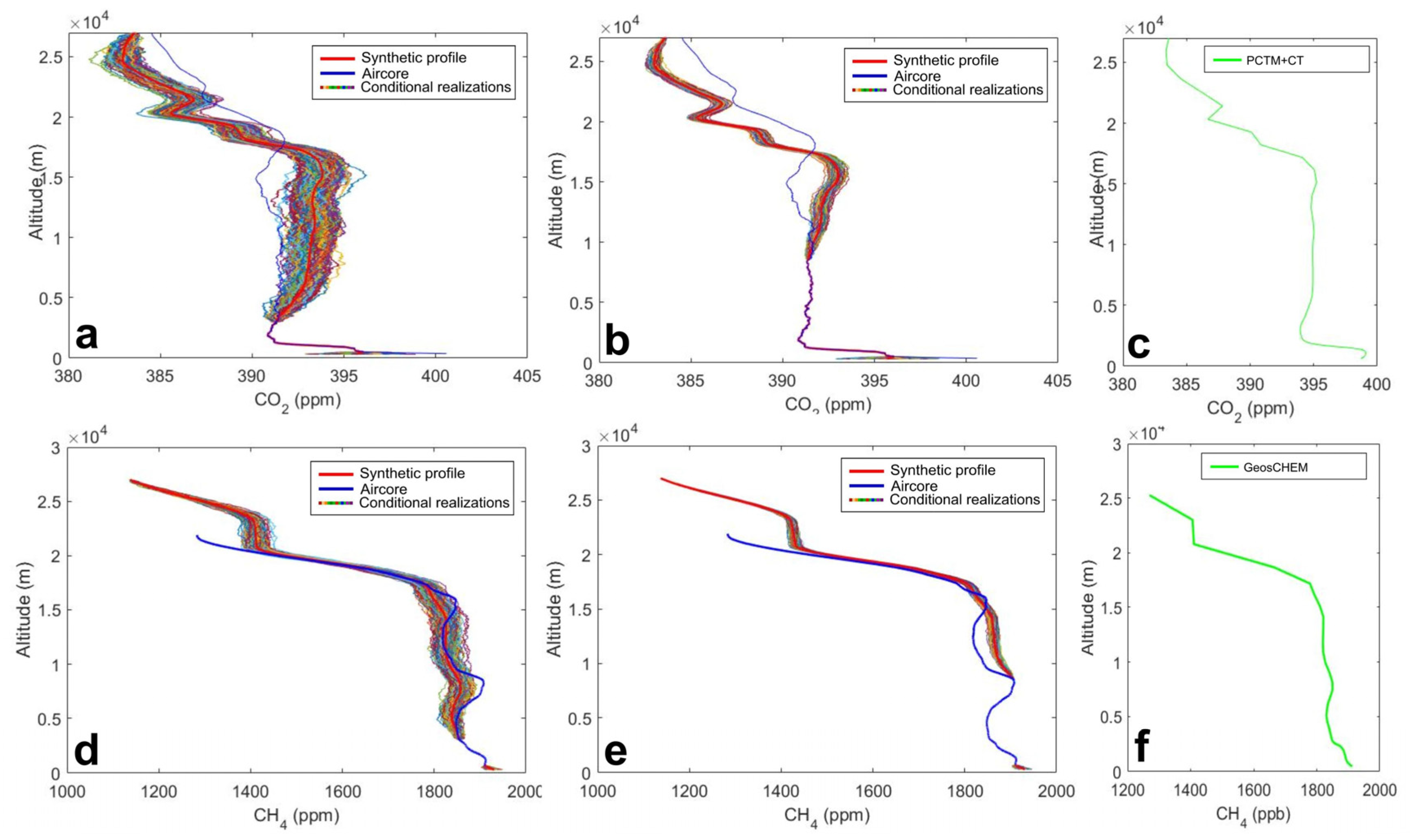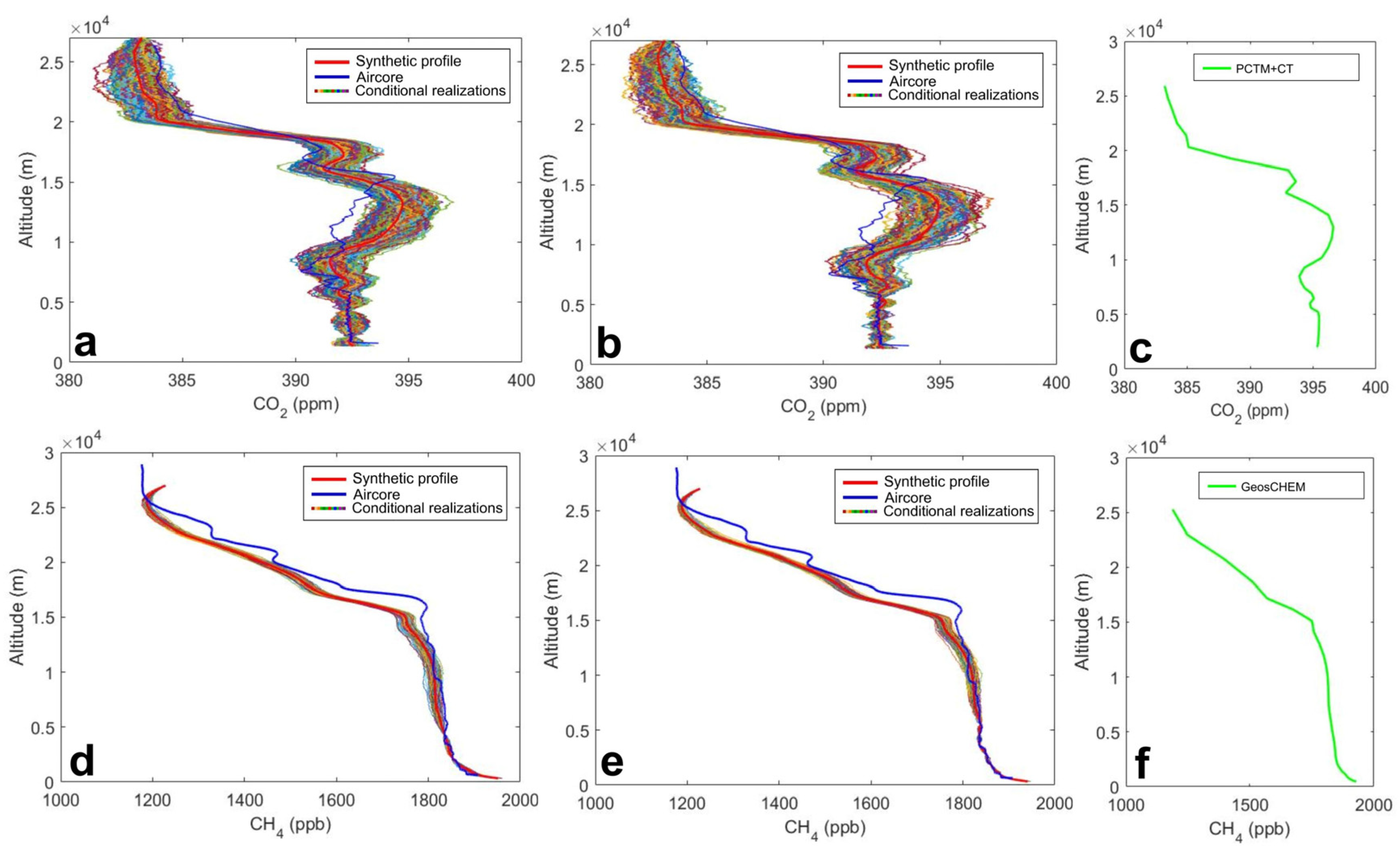An Approach to Estimate Atmospheric Greenhouse Gas Total Columns Mole Fraction from Partial Column Sampling
Abstract
1. Introduction
2. Materials and Methods
2.1. Materials
2.1.1. AirCore Observations
2.1.2. Atmospheric Transport Models
2.2. Methods
2.2.1. Interpolation Method
2.2.2. Scenario 1: Partial Column Profiles Available
2.2.3. Scenario 2: Only Discrete Profiles Available
3. Results and Discussion
3.1. Covariance Model Selection and Local Parameter Inference
3.2. Simulation of the Full-Column (Synthetic) Profiles
3.2.1. Scenario 1: Partial Column Profiles Available
3.2.2. Scenario 2: Only Discrete Profiles Available
3.3. Uncertainty Analysis and Potential Method Applicability
3.4. Comparison with TCCON Retrievals
3.5. Conceptual Comparison to Classical Approach
4. Conclusions
Supplementary Materials
Author Contributions
Funding
Acknowledgments
Conflicts of Interest
Appendix A
Residual (Regression) Kriging
Appendix B
Conditional Simulations
References
- Miyamoto, Y.; Inoue, M.; Morino, I.; Uchino, O.; Yokota, T.; Machida, T.; Sawa, Y.; Matsueda, H.; Sweeney, C.; Tans, P.P.; et al. Atmospheric column-averaged mole fractions of carbon dioxide at 53 aircraft measurement sites. Atmos. Chem. Phys. 2013, 13, 5265–5275. [Google Scholar] [CrossRef]
- Tadić, J.M.; Loewenstein, M.; Frankenberg, C.; Butz, A.; Roby, M.; Iraci, L.T.; Yates, E.L.; Gore, W.; Kuze, A. A comparison of in-situ aircraft measurements of carbon dioxide and methane to GOSAT data measured over Railroad Valley playa, Nevada, USA. IEEE Trans. Geosci. Remote Sens. 2014, 52, 7764–7774. [Google Scholar] [CrossRef]
- Tanaka, T.; Miyamoto, Y.; Morino, I.; Machida, T.; Nagahama, T.; Sawa, Y.; Matsueda, H.; Wunch, D.; Kawakami, S.; Uchino, O. Aircraft measure-ments of carbon dioxide and methane for the calibration of ground-based high-resolution Fourier Transform Spectrometers and a comparison to GOSAT data measured over Tsukuba and Moshiri. Atmos. Meas. Tech. 2012, 5, 2003–2012. [Google Scholar] [CrossRef]
- Inoue, M.; Morino, I.; Uchino, O.; Miyamoto, Y.; Yoshida, Y.; Yokota, T.; Machida, T.; Sawa, Y.; Matsueda, H.; Sweeney, C.; et al. Validation of XCO2 derived from SWIR spectra of GOSAT TANSO-FTS with aircraft measurement data. Atmos. Chem. Phys. 2013, 13, 9771–9788. [Google Scholar] [CrossRef]
- Wunch, D.; Toon, G.C.; Blavier, J.-F.L.; Washenfelder, R.A.; Notholt, J.; Connor, B.J.; Griffith, D.W.T.; Sherlock, V.; Wennberg, P.O. The Total Carbon Column Observing Network. Phil. Trans. R. Soc. A 2011, 369, 2087–2112. [Google Scholar] [CrossRef] [PubMed]
- Messerschmidt, J.; Geibel, M.C.; Blumenstock, T.; Chen, H.; Deutscherm, N.M.; Engel, A.; Feist, D.G.; Gerbig, C.; Gisi, M.; Hase, F.; et al. Calibration of TCCON column-averaged CO2: The first aircraft campaign over European TCCON sites. Atmos. Chem. Phys. 2011, 11, 10765–10777. [Google Scholar] [CrossRef]
- Deutscher, N.M.; Griffith, D.W.T.; Bryant, G.W.; Wennberg, P.O.; Toon, G.C.; Washenfelder, R.A.; Keppel-Aleks, G.; Wunch, D.; Yavin, Y.; Allen, N.; et al. Total column CO2 measurements at Darwin, Australia—Site description and calibration against in situ aircraft profiles. Atmos. Meas. Tech. 2010, 3, 947–958. [Google Scholar] [CrossRef]
- Geibel, M.C.; Messerschmidt, J.; Gerbig, C.; Blumenstock, T.; Chen, H.; Hase, F.; Kolle, O.; Lavrič, J.V.; Notholt, J.; Palm, M.; et al. Calibration of column-averaged CH4 over European TCCON FTS sites with airborne in-situ measurements. Atmos. Chem. Phys. 2012, 12, 8763–8775. [Google Scholar] [CrossRef]
- Biraud, S.C.; Torn, M.S.; Smith, J.R.; Sweeney, C.; Riley, W.J.; Tans, P.P. A multi-year record of airborne CO2 observations in the US Southern Great Plains. Atmos. Meas. Tech. 2013, 6, 751–763. [Google Scholar] [CrossRef]
- Inoue, M.; Morino, I.; Uchino, O.; Miyamoto, Y.; Saeki, T.; Yoshida, Y.; Yokota, T.; Sweeney, C.; Tans, P.P.; Biraud, S.C.; et al. Validation of XCH4 derived from SWIR spectra of GOSAT TANSO-FTS with aircraft measurement data. Atmos. Meas. Tech. 2014, 7, 2987–3005. [Google Scholar] [CrossRef]
- O’Dell, C.W.; Connor, B.; Bösch, H.; O’Brien, D.; Frankenberg, C.; Castano, R.; Christi, M.; Eldering, D.; Fisher, B.; Gunson, M.; et al. The ACOS CO2 retrieval algorithm—Part 1: Description and validation against synthetic observations. Atmos. Meas. Tech. 2012, 5, 99–121. [Google Scholar] [CrossRef]
- Foucher, P.Y.; Chedin, A.; Armante, R.; Boone, C.; Crevoisier, C.; Bernath, P. Carbon dioxide atmospheric vertical profiles retrieved from space observation using ACE-FTS solar occultation instrument. Atmos. Chem. Phys. 2011, 11, 2455–2470. [Google Scholar] [CrossRef]
- Bakwin, P.S.; Tans, P.P.; Stephens, B.B.; Wofsy, S.C.; Gerbig, C.; Grainger, A. Strategies for measurement of atmospheric column means of carbon dioxide from aircraft using discrete sampling. J. Geophys. Res. 2003, 108, 4514. [Google Scholar] [CrossRef]
- Karion, A.; Sweeney, C.; Tans, P.; Newberger, T. AirCore: An Innovative Atmospheric Sampling System. J. Atmos. Ocean. Tech. 2010, 27, 1839–1853. [Google Scholar] [CrossRef]
- Membrive, O.; Crevoisier, C.; Sweeney, C.; Danis, F.; Hertzog, A.; Engel, A.; Bönisch, H.; Picon, L. AirCore-HR: A high-resolution column sampling to enhance the vertical description of CH4 and CO2. Atmos. Meas. Tech. 2017, 10, 2163–2181. [Google Scholar] [CrossRef]
- Kawa, S.R.; Erickson, D.J.; Pawson, S.; Zhu, Z. Global CO2 transport simulations using meteorological data from the NASA data assimilation system. J. Geophys. Res. 2004, 109. [Google Scholar] [CrossRef]
- Pickett-Heaps, C.A.; Jacob, D.J.; Wecht, K.J.; Kort, E.A.; Wofsy, S.C.; Diskin, G.S.; Worthy, D.E.J.; Kaplan, J.O.; Bey, I.; Drevet, J. Magnitude and seasonality ofwetland methane emissions from the Hudson Bay Lowlands (Canada). Atmos. Chem. Phys. 2011, 11, 3773–3779. [Google Scholar] [CrossRef]
- Wecht, K.J.; Jacob, D.J.; Wofsy, S.C.; Kort, E.A.; Worden, J.R.; Kulawik, S.S.; Henze, D.K.; Kopacz, M.; Payne, V.H. Validation of TES methane with HIPPO aircraft observations: Implications for inverse modeling of methane sources. Atmos. Chem. Phys. 2012, 12, 1823–1832. [Google Scholar] [CrossRef]
- Turner, A.J.; Jacob, D.J.; Wecht, K.J.; Maasakkers, J.D.; Lundgren, E.; Andrews, A.E.; Biraud, S.C.; Boesch, H.; Bowman, K.W.; Deutscher, N.M.; et al. Estimating global and North American methane emissions with high spatial resolution using GOSAT satellite data. Atmos. Chem. Phys. 2015, 15, 7049–7069. [Google Scholar] [CrossRef]
- Rienecker, M.M.; Suarez, M.J.; Gelaro, R.; Todling, R.; Bacmeister, J.; Liu, E.; Bosilovich, M.G.; Schubert, S.D.; Takacs, L.; Kim, G.K.; et al. MERRA: NASA’s modern-era retrospective analysis for research and applications. J. Clim. 2011, 24, 3624–3648. [Google Scholar] [CrossRef]
- Peters, W.; Jacobson, A.R.; Sweeney, C.; Andrews, A.E.; Conway, T.J.; Masarie, K.; Miller, J.B.; Bruhwiler, L.M.P.; Petron, G.; Hirsch, A.I.; et al. An atmospheric perspective on North American carbon dioxide exchange: CarbonTracker. Proc. Natl. Acad. Sci. USA 2007, 104, 18925–18930. [Google Scholar] [CrossRef] [PubMed]
- CarbonTracker CT2017. Available online: https://www.esrl.noaa.gov/gmd/ccgg/carbontracker/ (accessed on 22 June 2018).
- Wecht, K.J.; Jacob, D.J.; Frankenberg, C.; Jiang, Z.; Blake, D.R. Mapping of North American methane emissions with high spatial resolution by inversion of SCIAMACHY satellite data. J. Geophys. Res. Atmos. 2014, 119, 7741–7756. [Google Scholar] [CrossRef]
- Bruhwiler, L.; Dlugokencky, E.; Masarie, K.; Ishizawa, M.; Andrews, A.; Miller, J.; Sweeney, C.; Tans, P.; Worthy, D. CarbonTracker-CH4: An assimilation system for estimating emissions of atmospheric methane. Atmos. Chem. Phys. 2014, 14, 8269–8293. [Google Scholar]
- Trends in Global CO2 Emissions: 2015 Report. Available online: http://edgar.jrc.ec.europa.eu/news_docs/jrc-2015-trends-in-global-co2-emissions-2015-report-98184.pdf (accessed on 22 June 2018).
- Van der Werf, G.R.; Randerson, J.T.; Giglio, L.; Collatz, G.J.; Mu, M.; Kasibhatla, P.S.; Morton, D.C.; DeFries, R.S.; Jin, Y.; van Leeuwen, T.T. Global fire emissions and the contribution of deforestation, savanna, forest, agricultural, and peat fires (1997–2009). Atmos. Chem. Phys. 2010, 10, 11707–11735. [Google Scholar] [CrossRef]
- Akagi, S.K.; Yokelson, R.J.; Wiedinmyer, C.; Alvarado, M.J.; Reid, J.S.; Karl, T.; Crounse, J.D.; Wennberg, P.O. Emission factors for open and domestic biomass burning for use in atmospheric models. Atmos. Chem. Phys. 2011, 11, 4039–4072. [Google Scholar] [CrossRef]
- File Specification for GEOS-5 FP. GMAO Office Note No. 4 (Version1.0). 2013. Available online: http://acmg.seas.harvard.edu/geos/wiki_docs/geos5/GEOS_5_FP_File_Specification_ON4v1_0.pdf (accessed on 22 June 2018).
- CarbonTracker-CH4. Available online: https://www.esrl.noaa.gov/gmd/ccgg/carbontracker-ch4/ (accessed on 22 June 2018).
- Hengl, T.; Geuvelink, G.B.M.; Stein, A. Comparison of Kriging with External Drift and Regression-Kriging. Technical Note, ITC. 2003. Available online: https://webapps.itc.utwente.nl/librarywww/papers_2003/misca/hengl_comparison.pdf (accessed on 22 June 2018).
- Haas, T.C. Lognormal and moving window methods of estimating acid deposition. J. Am. Stat. Assoc. 1990, 85, 950–963. [Google Scholar] [CrossRef]
- Laiti, L.; Zardi, D.; de Franceschi, M.; Rampanelli, G. Residual Kriging analysis of airborne measurements: Application to the mapping of Atmospheric Boundary-Layer thermal structures in a mountain valley. Atmos. Sci. Lett. 2013, 14, 79–85. [Google Scholar] [CrossRef]
- Chiles, J.-P.; Delfiner, P. Geostatistics, 2nd ed.; Wiley: Hoboken, NJ, USA, 2012. [Google Scholar]
- Holdaway, M.R. Spatial modeling and interpolation of monthly temperature using kriging. Clim. Res. 1996, 6, 215–225. [Google Scholar] [CrossRef]
- Tadić, J.M.; Ilić, V.; Biraud, S. Examination of geostatistical and machine-learning techniques as interpolators in anisotropic atmospheric environments. Atmos. Environ. 2015, 111, 28–38. [Google Scholar] [CrossRef]
- Tadić, J.M.; Michalak, A.M. On the effect of spatial variability and support on validation of remote sensing observations of CO2. Atmos. Environ. 2016, 132, 309–316. [Google Scholar] [CrossRef]
- Ahmed, S.; de Marsily, G. Comparison of geostatistical methods for estimating transmissivity using data on transmissivity and specific capacity. Water Resour. Res. 1987, 23, 1717–1737. [Google Scholar] [CrossRef]
- Hengl, T.; Heuvelink, G.B.M.; Rossiter, D.G. About regression-kriging: From equations to case studies. Comput. Geosci. 2007, 33, 1301–1315. [Google Scholar] [CrossRef]
- Sweeney, C.; Karion, A.; Wolter, S.; Newberger, T.; Guenther, D.; Higgs, J.A.; Andrews, A.E.; Lang, P.M.; Neff, D.; Dlugokencky, E.; et al. Seasonal climatology of CO2 across North America from aircraft measurements in the NOAA/ESRL Global Greenhouse Gas Reference Network. J. Geophys. Res. Atmos. 2015, 120, 5155–5190. [Google Scholar] [CrossRef]
- Tans, P.P.; Bakwin, P.S.; Guenther, D.W. A feasible global carbon cycle observing system: A plan to decipher today’s carbon cycle based on observations. Glob. Chang. Biol. 1996, 2, 309–318. [Google Scholar] [CrossRef]
- Inoue, M.; Morino, I.; Uchino, O.; Nakatsuru, T.; Yoshida, Y.; Yokota, T.; Wunch, D.; Wennberg, P.O.; Roehl, C.M.; Griffith, D.W.T.; et al. Bias corrections of GOSAT SWIR XCO2 and XCH4 with TCCON data and their evaluation using aircraft measurement data. Atmos. Meas. Tech. 2016, 9, 3491–3512. [Google Scholar] [CrossRef]
- The Earth Model—Calculating Field Size and Distances between Points Using GPS Coordinates. Available online: http://www.ipni.net/publication/ssmg.nsf/0/0BDF314BF75B9FC1852579E5007691F9/$FILE/SSMG-11.pdf (accessed on 22 June 2018).
- Li, J.; Heap, A. A Review of Spatial Interpolation Methods for Environmental Scientists; Geoscience Australia: Canberra, Australia, 2008; p. 137. [Google Scholar]
- Zhou, Y.; Obenour, D.R.; Scavia, D.; Johengen, T.H.; Michalak, A.M. Spatial and temporal trends in Lake Erie hypoxia, 1987–2007. Environ. Sci. Technol. 2013, 47, 899–905. [Google Scholar] [CrossRef] [PubMed]




| Greenhouse Gas | Parameters | Partial Profiles (<m amsl) | Number of Flasks, 0–6500 m | |||||||
|---|---|---|---|---|---|---|---|---|---|---|
| 3000 | 5500 | 6500 | 7500 | 8500 | 1 | 2 | 6 | 12 | ||
| CO2 | MAE (ppm) | 0.76 | 0.50 | 0.37 | 0.36 | 0.32 | 0.60 | 0.44 | 0.49 | 0.51 |
| 95% MAE confidence interval | 0.41 | 0.25 | 0.17 | 0.16 | 0.12 | 0.34 | 0.20 | 0.18 | 0.25 | |
| σ (ppm) | 0.93 | 0.66 | 0.50 | 0.48 | 0.44 | 0.69 | 0.54 | 0.69 | 0.66 | |
| Unbiased σ (ppm) | 0.60 | 0.44 | 0.36 | 0.35 | 0.34 | 0.45 | 0.42 | 0.54 | 0.45 | |
| CH4 | MAE (ppb) | 7.72 | 7.67 | 8.6 | 11.23 | 9.85 | 8.84 | 10.51 | 7.47 | 8.00 |
| 95% MAE confidence interval | 5.74 | 5.18 | 5.94 | 8.81 | 6.67 | 5.62 | 5.13 | 5.72 | 6.01 | |
| σ (ppb) | 10.26 | 8.94 | 10.00 | 15.71 | 11.22 | 12.66 | 13.60 | 10.30 | 10.46 | |
| Unbiased σ (ppb) | 10.02 | 9.04 | 10.37 | 15.36 | 11.63 | 9.81 | 8.96 | 9.99 | 10.48 | |
© 2018 by the authors. Licensee MDPI, Basel, Switzerland. This article is an open access article distributed under the terms and conditions of the Creative Commons Attribution (CC BY) license (http://creativecommons.org/licenses/by/4.0/).
Share and Cite
Tadić, J.M.; Biraud, S.C. An Approach to Estimate Atmospheric Greenhouse Gas Total Columns Mole Fraction from Partial Column Sampling. Atmosphere 2018, 9, 247. https://doi.org/10.3390/atmos9070247
Tadić JM, Biraud SC. An Approach to Estimate Atmospheric Greenhouse Gas Total Columns Mole Fraction from Partial Column Sampling. Atmosphere. 2018; 9(7):247. https://doi.org/10.3390/atmos9070247
Chicago/Turabian StyleTadić, Jovan M., and Sébastien C. Biraud. 2018. "An Approach to Estimate Atmospheric Greenhouse Gas Total Columns Mole Fraction from Partial Column Sampling" Atmosphere 9, no. 7: 247. https://doi.org/10.3390/atmos9070247
APA StyleTadić, J. M., & Biraud, S. C. (2018). An Approach to Estimate Atmospheric Greenhouse Gas Total Columns Mole Fraction from Partial Column Sampling. Atmosphere, 9(7), 247. https://doi.org/10.3390/atmos9070247





